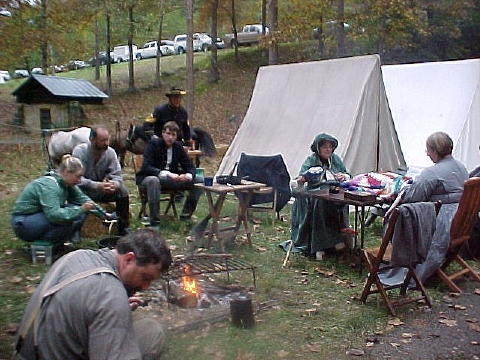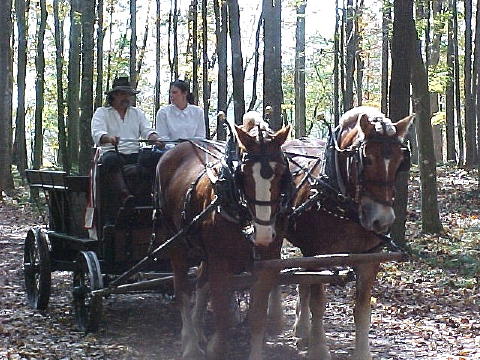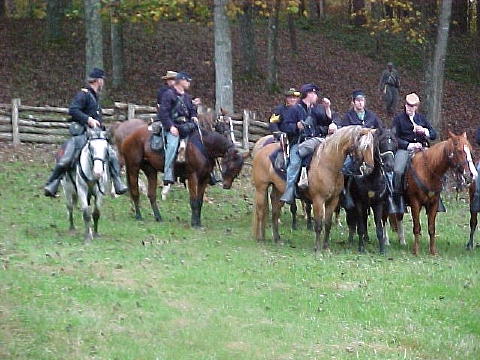BULLTOWN CIVIL WAR REENACTMENT - "Hurrah For Jeff Davis" Got Cunningham Shot

Photo by John David Stump

Photo by Burl Postalwait
The Bulltown Civil War Battle Reenactment was recently held at at the Bulltown Historic Area, located near Burnsville Lake on the Little Kanawha River.
Hundreds of people helped with the semi-annual reenactment, which was well attended.
The Battle of Bulltown was fought on October 13, 1863, a skirmish lasting about twelve hours.
The Confederate forces were led by Colonel William L. "Mudwall" Jackson (a native of Lewis County and first cousin of Thomas J. "Stonewall" Jackson).
The Confederates attacked the Union forces at 4:30 a.m. The Union forces, led by Captain Mattlingly, repelled the attack on their fortifications and the battle finally ended about 4:30 p.m.
There were apparently casualties on both sides, and one civilian casualty - Moses Cunningham - who ran out of his farmhouse into the line of fire and shouted "Hurrah for Jeff Davis!" He was clipped by a bullet but recovered.

Photo by John David Stump

Photo by John David Stump
The Bulltown Historic Area includes a visitor's center, structures dating back to mid to late 1800s, and a Civil War battlefield with preserved trenches. Tours of the area may be arranged through the staff at the visitor's center or you can take a self-guided tour using various interpretive plaques placed throughout the area.
The campground offers 204 campsites along with playgrounds and bathhouses. A boat launch is located in the campground and there is a beach about a mile away. Other activities include hiking, boating, wildlife observation, fishing, hunting, picnicking and sightseeing. There are two stores located near the campground, one at the entrance and one three miles away. Groceries, camping supplies, and bait can be found here.
AMONG THE SITES AT BULLTOWN
Weston and Gauley Turnpike
During the Civil War, the mountainous West Virginia terrain had few transportation routes. This turnpike was used by both sides - Union and Confederate - to transport troops, supplies, and carry communications. There were many skirmishes along it including the Battle of Bulltown.
Cunningham House
This log house, owned by the Cunningham family since the time it was built in the early 1800s until purchased by the Corps of Engineers in the 1970s, is representative of the "dogtrot" style typically found in the South. The two-pen structure is two stories high and has a breezeway in the middle and hand-hewn stone fireplaces with exterior stone chimneys at each end of the house. The house has been sided, a porch added, the breezeway enclosed, and other additions made over the years.
The house was the center of the small subsistence farm where all the family members cooperated in caring for the crops and livestock. In addition, the farmstead included a granary, coal and wood house, spring house, food cellar, outhouse and barn. The granary is the oldest outbuilding on the farm. The spring house (no longer here) was built over a spring where fresh, clean water could be pumped or dipped out by hand for the family's use. The cool water in the spring house refrigerated the farm eggs, milk, butter, and other dairy products. Today, the house, granary, food cellar, and outhouse remain and are in their original locations.
St. Michael's Church
Built in the 19th century as a mission church of St. Patrick's in Weston, West Virginia, St. Michael's soon became a part of the Sand Fork pastorate. It was closed in 1912 and the congregation moved to Orlando. Originally a rectangular log structure, it was sided with wood clapboard and painted white about ten years after it was built.
Fleming House
Built prior to 1900, this double-pen style log dwelling is common in central West Virginia. Half-dovetail notching was used on most of the logs, and the two pens, or rooms of the house, were joined by mortise construction. The house, in later years, was covered with vertical boards on the front and narrow poplar clapboards on the other three sides, and painted white.
McCauley Barn
Built in the nineteenth century, the original structure was rectangular in shape with a loft and a gabled roof as you see now. D.W. "Joe" McCauley purchased the barn in 1928 and added three sheds about 1933 - a three-stall horse shed on the left side, a cow milking shed on the right side, and a hay shed across the back. The barn was originally located on Knawls Creek about 2 miles away.
Johnson House
Built around 1883, this two story log structure was owned by the Johnson family until purchased by the Corps of Engineers in the 1970s. The unusual cat and clay chimney is made of wooden slats daubed with mud. At one time, the house had a frame addition on the rear which was divided into two bedrooms, and a frame addition on the side which served as a kitchen.